Catalogue > List by artist
Browse the entire list of Rencontre Internationales artists since 2004. Use the alphabetical filter to refine your search. update in progress
Nicolas Wackerbarth
Catalogue : 2008Halbe Stunden | Fiction | 35mm | color | 20:0 | Germany | 2007
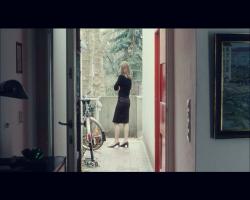
Nicolas Wackerbarth
Halbe Stunden
Fiction | 35mm | color | 20:0 | Germany | 2007
Melanie lives aimlessly into the day, or more accurately: into a Friday. She's alone at home. "Half Hours" describes the time you have for yourself. Before someone arrives, after someone has left. If you gazing into space too long, you could lose yourself. Time lenghthens itself, till it becomes a threat. A Thriller about an uneventful day.
Nicolas Wackerbarth Director, Writer and Actor. Co-editor of the film magazine "Revolver". 1992-93 studies of law. 1993-96 studies at the Bavarian Theatre Academy: Graduate Actor. 1996-97 State Theatre Of Frankfurt, 1997-99 State Theatre Of Cologne. Since 2000 studies at the dffb, German Film and Television Academy of Berlin. Films / Director (selection): brat (short film 2000), Lovesick - Max Ophüls Wettbewerb/ Hauptpreis Pathos Award München (short film 2003), ?Beginners!? - Price of the Jury Med Film Rom/ Best Video GLTurin Film Fest. (TV, 2004) Westerntown (documentary 2005), Half Hours - Cannes Cinéfondation/ Kurzfilmtage Oberhausen (short film 2007)
Emmanuelle Waeckerle, Jimmy ROBERT
Catalogue : 2006Newsflash | Art vidéo | dv | color | 8:4 | France, United Kingdom | 2004
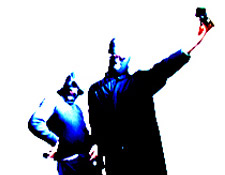
Emmanuelle Waeckerle, Jimmy ROBERT
Newsflash
Art vidéo | dv | color | 8:4 | France, United Kingdom | 2004
In a series of slapstick tableaux we respond with humour and pathos to media manipulation in relation to War and Terrorism - while attempting to make a personal sign of protest. Behind our seemingly desperate satire and selfmocking attitude lurks a critique of violence and demagogy. Originally devised as a performance for Berlin International Meetings 2003 @ La gaite Lyrique in Paris -Feb 2003, as a personal response to the war ?against Irak? that had just started. The work feels as timely now as it did then.
Emmanuelle Waeckerle's interdisciplinary practice evolves between sound language and the body, exploring their performative intersections. The idea of fluidity and flux in identity and space has been central to modernity and has always found its way into her multidisciplinary art practice - Perhaps due to her own experience of a mixed cultural background (from Morocco to France to England). But also as in Henri Michaux words ? one of the best remedy against one?s own vulnerability, dissatisfaction and fundamental sense of inadequacy in the world ?. She is currently exploring new technologies of interactivity in relation to using, hearing and seeing the voice and the possibilities of a vocal yet non-verbal communication. Research funded by London Arts and Surrey Institute of Art and Design where she is a senior lecturer in Visual Communication. Jimmy Robert is currently at the rijks akademie in Amsterdam, completing the 2 years postgraduate residency programme.. His work gravitates in the space between materiality and representation, evolving from photography towards film and performance as well as writing. He attempts to activate the porosity of different identificatory supports such as literature and cinema, to reach beyond the page or the screen by merging with the image or embodying the text.
Beny Wagner
Catalogue : 2021Coal Mine in the Canary | Experimental doc. | mp4 | color | 18:34 | Germany, United Kingdom | 2020
Beny Wagner
Coal Mine in the Canary
Experimental doc. | mp4 | color | 18:34 | Germany, United Kingdom | 2020
An essay film told through the body, 'Coal Mine in the Canary' explores the work of John Scott Haldane, the late 19th century physiologist whose experiments with respiration in atmospheric extremes led him to put canaries in coal mines as early indicators of air toxicity. The film explores this historical technique as a form of environmental control, one that would ultimately shape the possibilities of exchange between organisms and their surroundings, determined as a series of regulated variables. In the canary, Haldane developed a new paradigm: to modify an organism is a form of environmental control because there is no border at which the organism begins and the environment ends.
Beny Wagner is an artist, filmmaker, researcher and writer. Working in moving image, text, installation and lectures, he constructs non-linear narratives situated within the ever shifting threshold of the human body. ? He has presented his work in festivals, exhibitions and conferences internationally including: Berlinale, International Film Festival Rotterdam, Eye Film Museum, Haus der Kulturen der Welt, Media Art Biennale WRO, 5th and 6th Moscow Biennale for Young Art, Moscow International Experimental Film Festival, Plato Ostrava, Künstlerhaus Bremen, Kunsthalle Amsterdam, Sonic Acts, Impakt Festival, Berlin Atonal, Venice Biennale, White Columns among many others. His work has been featured in Artforum, Spike Magazine Quarterly, Frieze Magazine, Kaleidoscope Press, Flash Art and Die Zeit. His writing has been published in Valiz and Sonic Acts Press among others.
Nicolas Wagnieres, benoit peverelli
Catalogue : 2008hotel jugoslavija 1.0 | Documentary | 16mm | color | 12:50 | Switzerland, Serbia | 2006
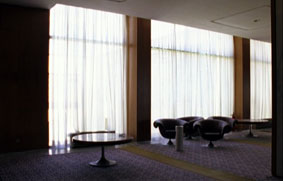
Nicolas Wagnieres, benoit peverelli
hotel jugoslavija 1.0
Documentary | 16mm | color | 12:50 | Switzerland, Serbia | 2006
This film traces the history of the JUGOSLAVIJA hotel in Belgrade, witness of past times and of the many historical changes the country has known. Through a voice over testimony of a previous director and former employees, the history of the building is unravelled and is partly recreated as the camera sweeps the rigorous architecture with long travelling and panoramic shots of the place and brings us to a building site-like present.
Gwenola Wagon
Catalogue : 2025Chroniques du soleil noir | Experimental fiction | hdv | color and b&w | 17:0 | France | 2023
Gwenola Wagon
Chroniques du soleil noir
Experimental fiction | hdv | color and b&w | 17:0 | France | 2023
In a dystopian future, humans have had to block out the sun in order to survive on Earth. Drought is extreme and the planet is gradually turning into a scorching desert where the survivors, installed in the basements of the great observatories, live in perpetual darkness. To compensate for the image of a sun they can no longer see, they instruct an artificial intelligence program to reconstruct it. The AI is supervised by a young woman whose mental images are particularly vivid. Drawing on the photo-novel structure of Chris Marker's film La Jetée (1962), Chronicles of the Dark Sun work on a science fiction narrative in which, as in Marker's film, an algorithm is tasked with reconstructing the past using an image from the protagonist's childhood. By recycling photographs from personal albums, advertising images and scientific snapshots, all of which are reprocessed by an AI, the film examines our relationship with technology in a disturbing and ironic way. This work is an uncanny fable that makes us think about the deformation of reality in AI as well as the unsustainability of our way of inhabiting the planet. Production with the support of Hangar Y, in partnership with l’Observatoire de Paris-PSL
Gwenola Wagon is an artist and researcher. She teaches at the Sorbonne School of Arts and the University of Paris 1. Through installations, films and books, she imagines alternative and paradoxical narratives for thinking about the contemporary digital world. With her first films, Globodrome, she surveyed the virtual globe, investigating the space of hyperinformation and Internet infrastructures in collaboration with artist Stéphane Degoutin, with whom she co-produced World Brain and the book Psychoanalysis of the International Airport. After Bienvenue à Erewhon, Virusland and Chroniques du soleil noir, post-cybernetic fables with Pierre Cassou-Noguès, she published Planète B, an essay that blends investigation and fiction in order to apprehend a rapidly expanding monster.
Kay Walkowiak
Catalogue : 2015Minimal Vandalism | Video | hdv | color | 3:49 | Austria | 2013
Kay Walkowiak
Minimal Vandalism
Video | hdv | color | 3:49 | Austria | 2013
Touching art objects in an exhibition space is usually not allowed. Not so in Kay Walkowiak´s Minimal Vandalism, where this prohibition is practically stomped on. The setting, the Generali Foundation in Vienna is the epitome of a modernist exhibition building, which—as neutral White Cube-like shell—is meant to intervene as little as possible in the act of viewing art.. Well, other than the tube-like enfilade with the massive concrete wall running down the middle along which a parcours of minimalist sculptures is set up in Minimal Vandalism. And it truly is a parcours, as after a brief exposition, in which the jerky camera movements already lead us to suspect that something’s up, an entirely unexpected performance unfolds. In one of the few calm takes, a surveillance camera soon becomes visible and the show begins: a skateboarder (Kilian Martin) coming from the depths of the room makes his approach on three boards piled on top of one another, to subject the sculptures to a test of endurance, or skill. The “performer” relentlessly includes the objects in his acrobatics, regardless of the fact that they are art, gliding up onto them, sliding across their surfaces, and daringly jumping over them.
*1980 in Salzburg, lives and works in Vienna. Several Grants and awards; e.g. Artist in Residence Grant Banff(2014), Beijing(2013), Varansi (2013), Theodor Körner Preis (2010), Otto Prutscher award (2008), Fred Adlmüller scholarship (2006). He studied philosophy and psychology at the University of Vienna, photography and video art at the Academy of fine Arts, Vienna and art & communication and sculture & multimedia art at the University of Applied Arts, Vienna.
Susanna Wallin
Catalogue : 2026Lizzy | Experimental doc. | 0 | color | 15:0 | Sweden, USA | 2024
Susanna Wallin
Lizzy
Experimental doc. | 0 | color | 15:0 | Sweden, USA | 2024
Lizzy is the result of the days spent in the aftermath of the death of a neighbour, who passed in the house where she had lived out her whole life on the Hillsborough River in Tampa, Florida and who left behind an electric organ addressed to the filmmaker, without a note. To receive it was like a wild riddle.How might one story continue in the hands of another? What powers organize the telling? Through weaving indoors with outdoors, dust with swamp, celebration with critique, the film traverses binary notions such as self-world, truth-fiction, witnessing-imagining and nature-experience among others.
Susanna Wallin is an artist and filmmaker engaged in questions regarding what to do with our time, our bodies and the tools we are given to live a life. She probes subject matter across diverse contexts, modalities and timescales, often immersing herself in a particular place over extended periods. She is attentive to what emerges in hesitation, together, through experimentation and open ended, lending an ear to the unspoken with fiction as practice. Born and raised in Sweden, she studied filmmaking and art practice/theory at Goldsmiths College and University of the Arts London in the UK. She has been the recipient of numerous awards including The Flamin London Artist Film and Video Award, New Approaches, Film London UK, Pure Fiction, Sweden and commissions from the UK Film Council, Channel 4, BBC, Arts Council England, Arte France/Germany, SVT, Sweden and the BFI in the UK. Her award-winning films are shown in cinema and gallery contexts and have appeared in venues such as MOCA LA, The American Cinematheque, The Barbican, Whitechapel Gallery, The London Underground, ICA and the British Film Institute. In recent years, Wallin has been developing several feature length film projects, one of which is set in Florida and now in post production. She is part of the Research School at University of the Arts London in the UK completing a PhD through practice and is Assistant Professor of Film and Video at University of South Florida in the US. She lives and works between Tampa and London.
Alexander Walmsley
Catalogue : 2025Memory Architecture | Experimental fiction | hdv | color | 14:29 | United Kingdom, Sweden | 2023
Alexander Walmsley
Memory Architecture
Experimental fiction | hdv | color | 14:29 | United Kingdom, Sweden | 2023
In Memory Architecture, a surveyor travels to the north of Sweden to survey a site for the building of a new data centre. This systematic task of transforming the terrain into a digital model quickly becomes a desperate search for some kind of underlying structure of the surveyor’s surroundings.
Alexander Walmsley (UK, b. 1992) is a filmmaker and photographer. In his research-based practice, he investigates how our understanding of the earth is shifting, mediated by the new technological, environmental and social realities of the 21st century. His recent work has been shown at the Daejeon Biennale of Arts and Sciences, Tirana Art Lab, Sharjah Art Foundation, The Photographers' Gallery, and Athens Digital Art Festival. He was a commissioned artist for the Albanian pavilion of the 59th Venice Biennale and was shortlisted for the Deloitte Photo Grant in 2023 and Istanbul 212 Photography Prize in 2021. He previously studied Anthropology and Archaeology at the University of Cambridge (UK) and the University of Geneva (CH), and is currently a lecturer at the Film University Konrad Wolf in Potsdam, Germany, where is also undertaking an artistic PhD on the subject of real-time representations of the planet.
Catalogue : 2023Tirana Time Capsules | Experimental VR | 4k | color | 0:0 | United Kingdom, Albania | 2021
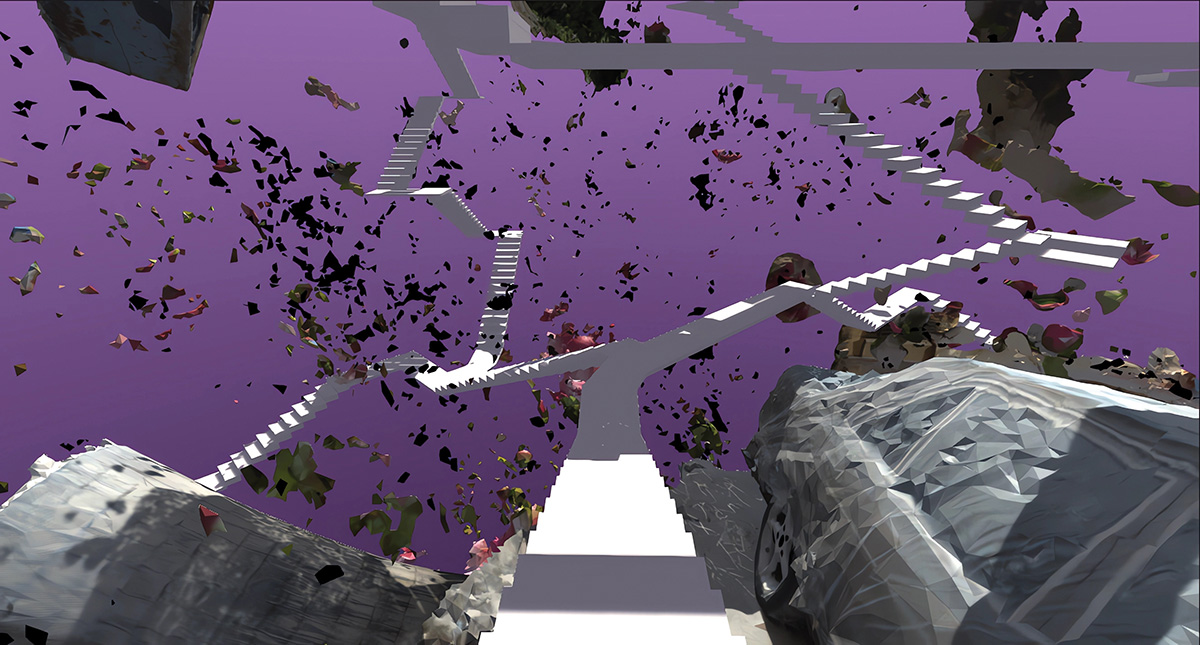
Alexander Walmsley
Tirana Time Capsules
Experimental VR | 4k | color | 0:0 | United Kingdom, Albania | 2021
The Tirana Time Capsules are a series of three virtual environments, accessible via web browser, that act as time capsules for three different neighbourhoods of Tirana in 2021. The chosen areas - 21 Dhjetori, Kombinat, and the Teatri i Gjelbërimit, an area of the Tirana Great Park - each embody different aspects of Tirana’s urban development over the past 100 years. Particularly since the early 2000s, this has been characterised by the gradual disappearance of public space as the building sector has increasingly become controlled by private interests. Drawing on the metaphor of the time capsule and employing so-called high-fidelity recording techniques such as photogrammetry and field recording, the work re-appropriates and re-constitutes these different areas of the city as virtual environments as a way of exploring the intersection of personal memory and community heritage. In addition, the work seeks to question the promises made by such recording technologies that claim to render and preserve reality as a high-fidelity digital copy: in short, what exactly is being preserved when we use these techniques of digital preservation?
Alexander Walmsley (b. 1992) is a media artist with a particular interest in the landscapes of the real and the virtual. In his practice, he investigates how our understanding of these landscapes is shifting, mediated by the new technological, environmental and social realities of the 21st century. His work is situated primarily between 3D, photography, animation, and XR. His recent work has been shown at the Daejeon Biennale of Arts and Sciences, Tirana Art Lab, Sharjah Art Foundation, The Photographers' Gallery, and VRHam! Festival. He was a commissioned artist for the Albanian pavilion of the 59th Venice Biennale and has taken part in residencies at the Tirana Art Lab, Albania, and Moskosel Creative Lab, Sweden, among others. Previously, he studied Anthropology and Archaeology at the Universities of Cambridge (UK) and Geneva (CH).
Calum Walter
Catalogue : 2017Unknown Hours | Video | hdv | color | 12:30 | USA | 2016
Calum Walter
Unknown Hours
Video | hdv | color | 12:30 | USA | 2016
Unknown Hours studies a precarious nightscape. An observer journeys down a main street in Chicago towards a neighborhood known for its nightlife. The moving image is slowed to reveal the intermittence of street lights and sports bar televisions. A camera peers into the moments between events.
Calum Walter is a filmmaker, artist and sound designer. He has a BFA from the University of Colorado where he studied filmmaking with an emphasis on sound, and later received a MFA from the School of the Art Institute of Chicago. He continues to do sound design and recording for his own films, and has collaborated with artists as cinematographer, sound recordist and designer. His work has screened widely at places including New York Film Festival, Toronto International Film Festival, Rotterdam International Film Festival, Slamdance, Ann Arbor Film Festival and the Big Ears Music Festival. He Teaches in the department of Radio/Television/Film at Northwestern University.
Michael Walter, Susanne BERGGREN
Catalogue : 2006Der Hörnermann | Experimental video | dv | color | 17:30 | Germany, Sweden | 2004
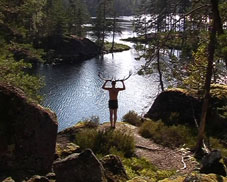
Michael Walter, Susanne BERGGREN
Der Hörnermann
Experimental video | dv | color | 17:30 | Germany, Sweden | 2004
?Der Hörnermann? - A phenomenal conceptual animal on a mediative passing through a landscape with horizons. The Hörnermann is a creature who is oscillating between nature and culture. In the shootings you see a human with horns held to his head slowly walking through the forest. At times he seems to be a foreigner to the landscape, masquerading to fit in or hide, at others he seems to be the sovereign, and at yet others he seems to be part of it, no longer human. Filmed in the urwald of Tiveden, Sweden, the imagery is beautiful, and refrains from becoming ironic but stays sensitive, both in compassion and accuracy in regards of the changing facets of the being of Hörnermann. ?It is quite strange in its simplicity, and in its refusal to show anything else than what it shows at first, aside from small variations (which consequently you tend to pay attention to). I like the sound(s) and the peacefulness and pacing that comes from the soundtrack. I like the fact that it?s not boring, and that on the opposite, in its own way it is quite funny. The Hörnermann?s gesture is so « suspended » (...) between a lot of different things that you can?t really pinpoint, that it keeps you guessing, even though it is very simple. I also like that it allows you to look at the landscape and enjoy it while ridding this action of its possible sentimentality and kitsch. ? Comment by J-P A
MICHAEL WALTER (*1966) works as visual artist. Various exhibitions in Europe. SUSANNE BERGGREN (Stockholm/Berlin) has worked as a choreographer since mid-nineties in the contexts of dance, visual arts and club. She normally works in close collaboration with artists from various fields, and produces works in different medias. Her work has been presented in Sweden and internationally. The last years she also worked extensively as a dancer with choreographers as Xavier LeRoy, Eszter Salamon, and Antonia Baehr, touring Europe. amongst others at Modern Dance-theatre, The Modern museum of Art, Fylkingen and various clubs and restaurants in Stockholm, Sweden, in Hau, Berlin, Thomas Nordanstad Gallery New York, Art Genda 2000, Helsinki, Wienna International Apartment, Wien and Åbo.
Alexia Walther, Maxime Matray
Catalogue : 2009L'élan | Fiction | 16mm | color | 15:24 | Switzerland, France | 2008
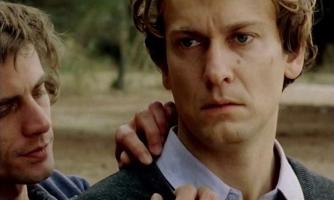
Alexia Walther, Maxime Matray
L'élan
Fiction | 16mm | color | 15:24 | Switzerland, France | 2008
Even nowadays, these things do happen sometimes: you get up at dawn, you`re accompanied, you walk throughout the woods, you get encouraged, you fear, you jabber, you play, you hum. You`re expected. You don`t have much to lose, but your honor.
Alexia Walther was born in Geneva in 1974, she lives and works in Nice and Paris. She graduated in 1999 from ESAV (École Supérieure d?Art Visuel), Geneva, Switzerland. She directed mixed media installations. Maxime Matray was born in 1973 in Paris. He lives and works in Nice and Paris. He graduated in 1995 from EPIAR (École Pilote Internationale d?Art et de Recherche), Villa Arson, Nice. He?s a mixed media artist and author. They started working together on the short-film TWIST (2006), that won several awards in many festivals. They wrote and directed together the short-film L?ÉLAN (THE RUN-UP).
Jan Wandrag
Catalogue : 2007David+Jonathan | Experimental fiction | dv | color | 15:0 | South Africa, USA | 2006
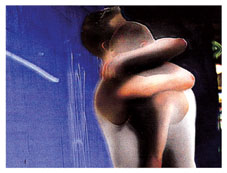
Jan Wandrag
David+Jonathan
Experimental fiction | dv | color | 15:0 | South Africa, USA | 2006
"David+Jonathan" is a non-straight street photography project. It is a retelling of the Bible story, set in modern day New York. After David defeats Goliath, the King takes an interest in him. David then develops a relationship with Jonathan, the King's son. When the King finds out about it, he forbids Jonathan to ever see David again. The building blocks of this film are a series of re-photographed stills. The images began as video shot in public, of young men unaware of the camera. Fictional scenes were composed from these images by digitally manipulating them and placing the actors found into the story.
Jan Wandrag was born in South Africa in 1976. His video work has been included in festivals in New York, Chicago, Dallas, and Washington, DC. Jan recently had his first solo gallery show, "Images of David+Jonathan", at Peter Hay Halpert Fine Art, New York. He has also participated in numerous group shows in the United States, South Africa, and Europe. Jan was awarded the Aaron Siskind Scholarship in 2004. In 2005 he completed a MFA in photography, video, and related media at the School of Visual Arts in New York City. He currently resides in New York with his partner David.
Joel Wanek
Catalogue : 2014Sun Song | Experimental doc. | hdv | color | 14:35 | USA | 2013
Joel Wanek
Sun Song
Experimental doc. | hdv | color | 14:35 | USA | 2013
A poetic journey from the darkness of early dawn into the brightness of the midday sun in the American South. Filmed on one bus route over the course of six months in Durham, North Carolina, Sun Song is a celebration of light and a meditation on leaving.
Joel Wanek (1974, Nebraska, USA) is a filmmaker and photographer living in Oakland. Over the years he has developed a creative documentary practice that often blurs the line between subject and maker, mixes techniques of narrative and vérité modes, and uses public spaces for collaborative engagement. He holds a MFA in Experimental and Documentary Arts from Duke University.
Lingjie Wang, Catherine Egloffe, Andrea Palade Flondor, HAO Jingfang, Serge Desire Ouedraogo, Bouna Cherif Fofana
Catalogue : 2013ouvrières ? | Experimental doc. | hdv | color | 10:46 | China | 2012
Lingjie Wang, Catherine Egloffe, Andrea Palade Flondor, HAO Jingfang, Serge Desire Ouedraogo, Bouna Cherif Fofana
ouvrières ?
Experimental doc. | hdv | color | 10:46 | China | 2012
Comment les ouvrières se voient à leur travail ? Pourquoi font elles ce métier ? Qui sont elles ? Pas seulement ici, mais aussi ailleurs. Le regard se concentre sur les femmes de l`industrie textile mais porte au delà d`un pays. Il va là où des artistes partagent cette même envie de regarder les femmes se regardant au travail. Ce qui importe d`abord c`est la manière dont chacune se voit, se pense. Les femmes parlent de leur désir, désir d`indépendance, pour le reste elles décrivent leur vie au travail, les difficultés, la dureté, le besoin de travailler, les peurs, les envies, les regrets... Souvent, elles se ressemblent, par leurs gestes attachés aux machines, mais aussi par leur histoire, le besoin d`argent, d`indépendance, certaines ont peur, d`autres se rebiffent, refusent. Ce qui importe aussi c`est la manière dont chaque artiste voit ces femmes au travail. Les croisements de regards, se font au gré des images et des paroles, sans autre guide que le jeu du loin et du proche, dans l`espace recomposé des usines, du rapport des corps aux machines, au travail.
«Images en transit », C`est un processus artistique collectif, qui a commencé en 2010 avec un travail expérimental sur le regard des femmes au travail, dans le textile. Nous sommes 6 artistes, de 3 continents, Europe, Afrique, Asie, qui avons imaginé peu à peu un dispositif pour travailler en collectif. Chacun a filmé dans son pays des ouvrières au travail, puis nous avons mis en commun les images. L?idée a été de réaliser une vidéo, avec une écriture commune, mais chacun a pu et pourra continuer à sa manière le travail engagé. Les images appartiennent au collectif et à chacun. Le temps de l`écriture collective a été celui du projet, puis celui du montage, chacun ?uvrant à partir des ses propres images et de celles des autres. Une centaines d?heures au total. Toutes les interviews ont été intégralement traduites. Le processus est expérimental et très ouvert donc. Nous ?uvrons sur l`écart des regards, l`écart dans le travail, des artistes et des femmes, les idées comme les images circulent. Co auteurs : Catherine Egloffe (France), WANG Lingjie (Chine), Andrea Palade Flondor (Roumanie), HAO Jingfang (Chine), Serge Desire Ouedraogo (Burkina Faso), Bouna Cherif Fofana (Mali)
Catalogue : 2012Flotter dans le noir | Experimental video | | color | 6:23 | China, Mali | 2011
Lingjie Wang, Jingfang HAO
Flotter dans le noir
Experimental video | | color | 6:23 | China, Mali | 2011
Wandering in the night, floating in the dark. Video filmed in February 2011 in Bamako, Mali, in the district Djicoroni Para, with the broadcast of muezzin`s calls. By the lacking of public street lighting, the landscape of the street is nothing familiar to us. The whole environment has changed. Houses, stores, waste, plants, even clothes of the passengers, everything is fading in the dark. We see the lights and shadows, the images taken. The movement of light and shadow built the memory of the territory that floats in time.
After his graduation as an engineer in industrial design in 2007, WANG Lingjie decided to continue his journey of creation by a more challenging and fundamental way, which leads him to start a 5 years study in contemporary art. WANG Lingjie has a various interests and so in the early years, he explored some different domains include: information technology, ecology and architecture, which he integrate to his creation of art works. Some after, influenced by his political background and thoughts of idealism, the artist focus his practices to installation, photography and video/motion picture which involve both fiction and documentary. By these mediums, he develops projects which reflect his thoughts on our existence, our relations with the nature and the univers. WANG Lingjie lives and works in Lorraine, France and Shanghai, China.
Lingjie Wang, Jingfang HAO
Catalogue : 2013ouvrières ? | Experimental doc. | hdv | color | 10:46 | China | 2012
Lingjie Wang, Catherine Egloffe, Andrea Palade Flondor, HAO Jingfang, Serge Desire Ouedraogo, Bouna Cherif Fofana
ouvrières ?
Experimental doc. | hdv | color | 10:46 | China | 2012
Comment les ouvrières se voient à leur travail ? Pourquoi font elles ce métier ? Qui sont elles ? Pas seulement ici, mais aussi ailleurs. Le regard se concentre sur les femmes de l`industrie textile mais porte au delà d`un pays. Il va là où des artistes partagent cette même envie de regarder les femmes se regardant au travail. Ce qui importe d`abord c`est la manière dont chacune se voit, se pense. Les femmes parlent de leur désir, désir d`indépendance, pour le reste elles décrivent leur vie au travail, les difficultés, la dureté, le besoin de travailler, les peurs, les envies, les regrets... Souvent, elles se ressemblent, par leurs gestes attachés aux machines, mais aussi par leur histoire, le besoin d`argent, d`indépendance, certaines ont peur, d`autres se rebiffent, refusent. Ce qui importe aussi c`est la manière dont chaque artiste voit ces femmes au travail. Les croisements de regards, se font au gré des images et des paroles, sans autre guide que le jeu du loin et du proche, dans l`espace recomposé des usines, du rapport des corps aux machines, au travail.
«Images en transit », C`est un processus artistique collectif, qui a commencé en 2010 avec un travail expérimental sur le regard des femmes au travail, dans le textile. Nous sommes 6 artistes, de 3 continents, Europe, Afrique, Asie, qui avons imaginé peu à peu un dispositif pour travailler en collectif. Chacun a filmé dans son pays des ouvrières au travail, puis nous avons mis en commun les images. L?idée a été de réaliser une vidéo, avec une écriture commune, mais chacun a pu et pourra continuer à sa manière le travail engagé. Les images appartiennent au collectif et à chacun. Le temps de l`écriture collective a été celui du projet, puis celui du montage, chacun ?uvrant à partir des ses propres images et de celles des autres. Une centaines d?heures au total. Toutes les interviews ont été intégralement traduites. Le processus est expérimental et très ouvert donc. Nous ?uvrons sur l`écart des regards, l`écart dans le travail, des artistes et des femmes, les idées comme les images circulent. Co auteurs : Catherine Egloffe (France), WANG Lingjie (Chine), Andrea Palade Flondor (Roumanie), HAO Jingfang (Chine), Serge Desire Ouedraogo (Burkina Faso), Bouna Cherif Fofana (Mali)
Catalogue : 2012Flotter dans le noir | Experimental video | | color | 6:23 | China, Mali | 2011
Lingjie Wang, Jingfang HAO
Flotter dans le noir
Experimental video | | color | 6:23 | China, Mali | 2011
Wandering in the night, floating in the dark. Video filmed in February 2011 in Bamako, Mali, in the district Djicoroni Para, with the broadcast of muezzin`s calls. By the lacking of public street lighting, the landscape of the street is nothing familiar to us. The whole environment has changed. Houses, stores, waste, plants, even clothes of the passengers, everything is fading in the dark. We see the lights and shadows, the images taken. The movement of light and shadow built the memory of the territory that floats in time.
After his graduation as an engineer in industrial design in 2007, WANG Lingjie decided to continue his journey of creation by a more challenging and fundamental way, which leads him to start a 5 years study in contemporary art. WANG Lingjie has a various interests and so in the early years, he explored some different domains include: information technology, ecology and architecture, which he integrate to his creation of art works. Some after, influenced by his political background and thoughts of idealism, the artist focus his practices to installation, photography and video/motion picture which involve both fiction and documentary. By these mediums, he develops projects which reflect his thoughts on our existence, our relations with the nature and the univers. WANG Lingjie lives and works in Lorraine, France and Shanghai, China.
Yuyan Wang
Catalogue : 2025The Moon Also Rises | Experimental doc. | hdv | color | 23:40 | China, France | 2024
Yuyan Wang
The Moon Also Rises
Experimental doc. | hdv | color | 23:40 | China, France | 2024
Just before the launch of artificial moons, a retired couple finds their harbor in the fading darkness. Trying to catch up with the pace of modernity, their daily life traces this forthcoming brightness back to its earthly origins.
Yuyan Wang (b. 1989, China) is a filmmaker and multidisciplinary artist. Her work focuses on the impact of image creation in media, representation, and the attention economy. By deconstructing and recontextualizing inherent meanings of found materials, her practice probes the continual mutations within the industrial production chain of images, a perpetual development leading to an abstraction of reality. Her work has been showcased at Tate Modern, Palais de Tokyo, the 12th Berlin Biennale and various festivals, such as Berlinale, IFFR, European Media Art Festival, Indie Lisboa, receiving numerous awards.
Chun Wang
Catalogue : 2026Budapest Is Grey And Blue, But Hell Is Purple | Experimental film | 0 | color and b&w | 16:10 | Taiwan, Hungary | 2023
Chun Wang
Budapest Is Grey And Blue, But Hell Is Purple
Experimental film | 0 | color and b&w | 16:10 | Taiwan, Hungary | 2023
These images appear in this world all because of an 18-year-old gypsy boy, Pisti. A chance encounter an existing gap in our chain of cause and effect. Like opening the door but realising there is no end, and now it cannot be closed no matter what. “I” is a place where events take place, an existential exploration.
WANG Chun (b. 1988, Taiwan) is a video production worker and film producer. His practice is based on transformations between different creative languages (those of image, text, sound, and body), searching for the limits of language and seeking to measure the distance in the act of viewing.
Franz Wanner
Catalogue : 2026Berlin-Lichtenberg | Documentary | mp4 | color and b&w | 7:20 | Germany | 2024
Franz Wanner
Berlin-Lichtenberg
Documentary | mp4 | color and b&w | 7:20 | Germany | 2024
The video Berlin-Lichtenberg uses footage from a home movie filmed in 1943. The apparent intention of the filmmaker – to capture peaceful moments of family life such as a wife and child on a walk or leisure time at a lakeside restaurant in the Berlin district of Lichtenberg – is disrupted by unintended visual content. In the background, everyday life in the forced labour system becomes visible: a group of female forced labourers on the way to their work site, and the barracks of a forced labour camp behind the excursion venue. These visual elements are not consciously chosen, but rather a casual documentation of the omnipresence of forced labour in Nazi Germany. The amateur footage has been re-edited for the video with intertitles that contextualise the silent images and add a fictional level.
In his artistic work, Franz Wanner (*1975 in Bad Tölz, Germany, lives in Zurich) addresses topics such as the European Union’s migration policy, the German secret service and the arms industry, as well as their history and current structures, and the effects of Nazism on the German imperative of prosperity. “In a conceptual practice whose consistency of research and artistic output, in the tradition of Hans Haacke, continues – by means of investigations and transmedia – to ask questions where no one has yet done so” (Nora Sternfeld, HFBK Hamburg), “he creates images of a collective cognitive dissonance and analytical poetry about the pathology of overlooking within the Germany of today and its idioms” (Stephanie Weber, Lenbachhaus Munich). As Artist in Residence at the Harun Farocki Institute, he developed the exhibition Mind the Memory Gap for the KINDL – Centre for Contemporary Art in Berlin. Under the title Eingestellte Gegenwarten, he realised his first solo exhibition in Italy at Merano Arte, which will be shown in modified form at the Lenbachhaus in Munich in 2026.
Feargal Ward, Jonathan Sammon
Catalogue : 2026Ivanko the Bear's Child | Experimental doc. | dcp | color | 25:0 | Ireland | 2024
Feargal Ward, Jonathan Sammon
Ivanko the Bear's Child
Experimental doc. | dcp | color | 25:0 | Ireland | 2024
A peasant’s wife loses her way in the forest and stumbles into a bear’s den. The bear keeps her with him, and after a time, a half-bear, half-child is born. They long to escape. To this backdrop, we move through the corridors and streets of a deserted German military town, once the central headquarters of the Soviet army’s occupation of Eastern Europe. Sealed off to the public for decades, this obscure complex became known to outsiders as “the Forbidden City.” A primal Russian fairy tale is employed to navigate this labyrinthine site, which appears to speak to both the legacy of this contested past and the unsettling resonances of our present.
Feargal Ward and Jonathan Sammon are filmmaking artists from Ireland. Much of their work explores the boundaries and possibilities of the hybrid-documentary form, where tropes and devices of narrative cinema are often appropriated or subverted in an attempt to interrogate established truths. Previous films they have collaborated on include 'Tin City', which premiered at this year’s Berlinale (Forum Expanded) before screening at multiple festivals including Karlovy Vary, Cinéma du Réel, and Festival dei Popoli, where it was awarded the International Discoveries Prize. Other collaborations involving Adrian Duncan include the films 'Lowland' (Cork International Film Festival), 'Memory Room' (IDFA, EVA International, Dokufest Kosovo), and 'Tension Structures' (IDFA, Hot Docs, RIDM). Ward’s feature documentary 'The Lonely Battle of Thomas Reid' premiered in the main competition at IDFA and screened at multiple festivals before being broadcast on German, Irish, and Finnish television. His debut feature documentary 'Yximalloo' (co-directed with Tadhg O’Sullivan) premiered at FID Marseille, where it won the Prix Premier
Dan Ward
Catalogue : 2017Performance | Experimental doc. | hdv | color | 18:0 | United Kingdom | 2015
Dan Ward
Performance
Experimental doc. | hdv | color | 18:0 | United Kingdom | 2015
A single day spent in a motion-capture studio documenting actors, a director and technical crew provide the subject matter for this film. Using a cliché B-movie script, the studio Audiomotion test workflow patterns to standardise and improve the production process (e.g. adjusting cameras and monitors, rehearsing with equipment, transferring data etc.) The actor’s movements are recorded during the scene, followed by minute facial gestures (aided with face paint), and finally edited as 3D models. We see how technique and dialogue must change to avoid disrupting the motion-capture technology, how the actors choose their expressions (stylised, but with an emphasis on naturalism), what other jobs the actors may have, and how standards or ideal gestures are created via these technical methods.
Dan Ward is a filmmaker based in London.
Phillip Warnell
Catalogue : 2021Intimate Distances | Experimental doc. | 4k | color | 61:0 | United Kingdom, USA | 2020
Phillip Warnell
Intimate Distances
Experimental doc. | 4k | color | 61:0 | United Kingdom, USA | 2020
On a street corner in Queens, New York, an elderly, white-haired woman hovers, apparently waiting or looking for something – then starts approaching passersby. Miked up close, but viewed – surveillance-style – from distant rooftops, she asks them philosophical questions about turning points in their lives, sometimes eliciting candidly revealing answers from people who seemingly need to talk. She’s also seen up close at street level, viewed by a shaky nearby camera. And intermittently we hear the affectless voiceover of an English male reading an account of a prison spell. What exactly are we seeing? A documentary of sorts? A fiction stripped of its expected signposts? The woman is real-life casting director Martha Wollner, but the film never makes it clear what her mission is, what she hopes to learn, and what her relation is to the distant speaker (who may also be the distant observer). Echoing Coppola’s THE CONVERSATION, as well as works by Phillip Warnell’s fellow British experimental directors John Smith and Chris Petit, this is an enigmatic, elusive piece. Yet, as the title suggests, those moments when Wollner connects with the interiority of perfect strangers makes this an alluringly, unexpectedly compassionate guerrilla foray into urban experience. (Jonathan Romney)
Phillip Warnell is an artist-filmmaker, a writer, and the director of the Visible Institute, for research in film and photography, at Kingston University, London. He produces film works and texts exploring a range of philosophical and poetic thematics, also exploring ideas on human-animal relations. His most recent film, The Flying Proletarian (2017), premiered at CPH:DOX, Copenhagen International Documentary Film Festival, in March 2017. During his fellowship, Warnell is addressing a series of interconnected questions on “animality-cinemality-criminality,” involving engagement with film professionals and researchers relative to screen-based roles and exploring the relationship among appearance, measurement, and typecasting. He is also developing script-based ideas for a planned feature-length film, currently in development, that investigates ideas on misobservation and apparitions of other life-worlds, accessing archival material to inform and incorporate into the project. Warnell’s film work has been exhibited extensively, including recent screenings at the ICA in London, KW Institute for Contemporary Art, in Berlin, and Tate Modern, in London, as well as in such prestigious film festivals as the Locarno Festival, the New York Film Festival, and the Viennale. Previous exhibitions have included at the Moderna galerija, in Ljubljana, Slovenia; Sharjah Biennial, in United Arab Emirates; and Wellcome Collection, in London. His film Ming of Harlem: Twenty One Storeys in the Air (2014) won the 2014 Georges de Beauregard International Prize at FID International Film Festival Marseille and the 2015 Universities SIC Award at IndieLisboa.
Catalogue : 2015Ming of Harlem: Twenty One Storeys in the Air | Documentary | | color | 70:0 | United Kingdom | 2014
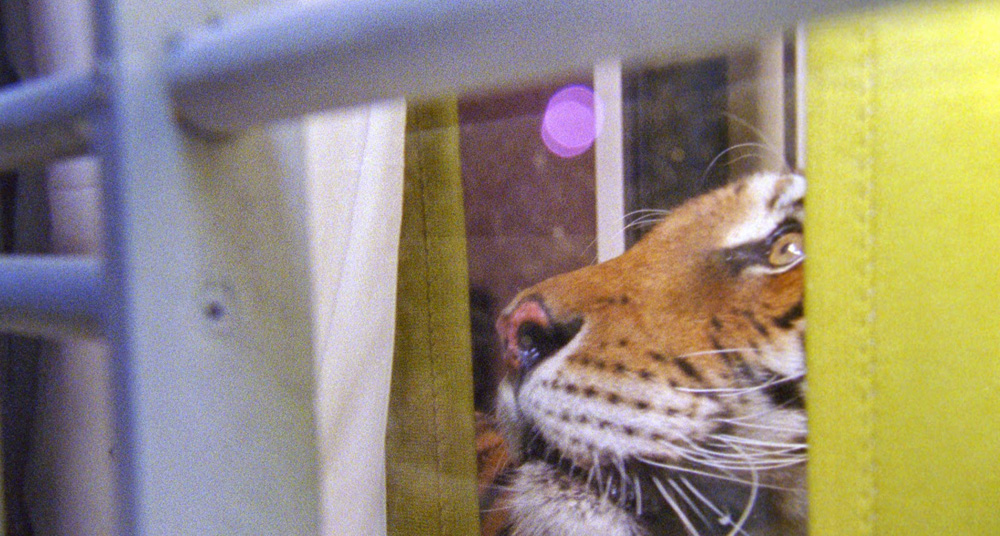
Phillip Warnell
Ming of Harlem: Twenty One Storeys in the Air
Documentary | | color | 70:0 | United Kingdom | 2014
Ming of Harlem: Twenty One Storeys in the Air is an only-in-New-York account of Ming, Al, and Antoine Yates, who cohabited in a high-rise social housing apartment at Drew-Hamilton complex in Harlem for several years until 2003, when news of their dwelling caused a public outcry and collective outpouring of disbelief. On the discovery that Ming was a 500-pound pound Tiger and Al a seven-foot alligator, their story took on an astonishing dimension. The film frames Yates’s recollections with a poetic study of Ming and Al, the predators’ presence combined with a text by philosopher Jean-Luc Nancy, reimagining the circumstances of the wild inside, animal names, strange territories, and human-animal relations.
Phillip Warnell is a filmmaker and academic based in London. He produces cinematic works exploring a range of philosophical ideas on human-animal relations and the poetics of bodily and life-world circumstances, where an interplay between film, politic and sensorium is played out. Augmented by interdisciplinary activities and partnership engagement, Warnell's recent output has involved an ongoing collaboration with philosopher and author Jean-Luc Nancy. His film work has screened internationally in festivals including: New York (NYFF, 2014); Vienna (Viennale, 2014); Marseille (FID, 2008, 09, 14); Amsterdam (IDFA, 2008, 14); Locarno (2012); Copenhagen (CPH-Dox, 2009, 14); Montreal (FNC, 2012, 14) and at curated screening programmes and exhibitions including Paris (Rencontres, 2008, 09, 12, 14); Sharjah Biennial (2013); Antwerp (Extra-City, 2014); Vienna (Fotogalerie, 2014); Tallinn (CCA, 2014). He has presented numerous performance-event works over an extended period, including at MACRO (Rome, 2004); ICA (London, 2006); Copenhagen (2009).
Catalogue : 2013I first saw the light | Experimental film | 16mm | color | 12:0 | United Kingdom | 2012
Phillip Warnell
I first saw the light
Experimental film | 16mm | color | 12:0 | United Kingdom | 2012
I first saw the light channels the vestige of Joseph Carey Merrick?s surviving output. Better known as The Elephant Man, he produced a two-page autobiography, sold to those attending a freak show in which he was displayed in victorian London. The inter-titled text is coupled with stark sequences of a model church he constructed, now sealed within a glass and ebony container, together forming the basis for this poignant, silent film. A reminder of Merrick?s profound humanity in the face of such extreme adversity, the film also serves as a footnote to David Lynch?s feature film, in which the model is employed as a central motif and metaphor for Merrick?s psychological and emotional fluctuations.
Phillip Warnell produces films channelling the circumstances, thoughts and character of extraordinary subjects. The work is concerned with the exploration of, and curiosity with, ideas around bodies and environments. Thinking through film, his work explores an extra-sensory, pre-scientific world, infused with invisible, supra-organic phenomena. The premise for his work locates the body as an axis or point of orientation, around which can be hosted a series of investigations and transformations, into both the human and animal corpus, its biology, psychology and chemistry. A filmmaker, academic and artist, Phillip Warnell presents his work in a range of contexts and guises: including live performance pieces, time-based work, image and text. His recent cinematic work has included ?The Girl with X-ray Eyes? and ?Outlandish: Strange Foreign Bodies?, made in collaboration with Jean-Luc Nancy. Recent presentations of his work include a solo exhibition at The South London Gallery, London (Sept, 2012); Locarno Film Festival (2012); FNC Montreal (2012), Loop Barcelona (2011); CPH-Dox (2010); FID Marseille (2009/8), with exhibitions at Matts Gallery, London (2005) and 300m3, Gothenburg (2008).
Catalogue : 2010Outlandish: étranges corps étrangers | Experimental doc. | 35mm | color | 20:0 | United Kingdom | 2009
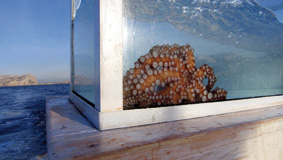
Phillip Warnell
Outlandish: étranges corps étrangers
Experimental doc. | 35mm | color | 20:0 | United Kingdom | 2009
Philosopher and heart transplant recipient Jean-Luc Nancy meditates on the history and integrity of bodies in Phillip Warnell?s new short 35mm film, Outlandish: Strange Foreign Bodies. A number of visual and literary passages explore the correlate between a textual narrative specially commissioned for the film, étranges corps étrangers, by Jean-Luc Nancy, his on screen presence, the surgical view of an organ in search of a body and an unaccounted for, displaced Cephalopod at sea. Presented in eight short episodes, together these form an odyssey on bodily migration. Outlandish is a journey threaded between shores and shared environments, the touching of and proximity between bodies, the vanishing and appearance of crew, the dimensions of the corpus and above all ? our relations with strange foreign bodies.
Phillip Warnell is an artist and filmmaker based in London. His work corresponds on a range of ideas concerning the desire for insight into the complex relations that constitute our bodies, the tension between the desire to get at and see the soul and the inherent elusiveness of this endeavour. The work traverses the boundaries of bodies, positioning them both as anatomical, physiological objects of research, and as intimate, distanced and transitional states. Whilst known especially for his keen attention towards notions of bodily transparency, embracing the combined use of historical artifacts with semiotics of the a-visual, his most recent output has assimilated more cinematic and textual imperatives, drawn from various collaborations and performative encounters. Recent exhibitions and screenings have included curated screenings at The BFI, London (08); festival screenings at FID Marseille (08 & 09), Copenhagen Documentary Festival (09); Bilbao Short Film Festival (08); DocBsAs, Buenos Aires (08). Exhibitions have included solo presentations at 300m3, Gothenburg; Leamington Spa Art Gallery, UK (both 2008); and a three-person exhibition at Matt?s Gallery, London (2005). Solo event/performances have included at MACRO, Rome (2006) and ICA, London (2006). He is currently Programme Director of Filmmaking at Kingston University, London.